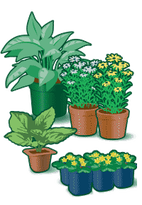Create a Rain Garden Design

Once you have a location and size for your garden, sketch it out on paper. Graph paper makes creating a sketch to scale a breeze. Mark where water will enter the garden and where the overflow is located.
 Next determine the mix of species you would like to use. It is important to remember that you are not creating a wetland; a rain garden is dry most of the time. Select flowers, grasses, and shrubs that are drought tolerant but can withstand wet conditions. Use sun or shade-loving plants depending on your location.
Next determine the mix of species you would like to use. It is important to remember that you are not creating a wetland; a rain garden is dry most of the time. Select flowers, grasses, and shrubs that are drought tolerant but can withstand wet conditions. Use sun or shade-loving plants depending on your location.
Native plants are adapted to local conditions, easy to maintain and attract birds and butterflies. In addition to the plants mentioned in the above templates, here are some other species to consider.
With your species list in tow, go back to your sketch and begin placing each plant. If you are planting a mix of shrubs, flowers, and grasses, make sure that you are accounting for the location of the sun during the summer months. Shrubs and taller grasses should be positioned so that they are not blocking the sun from lower growing sun-loving species. Most grasses and flowers should be spaced 10-12 inches apart on center.
RESOURCES
![]() Trouble figuring out how many plants you need to fill your garden? Try this easy calculator, which demonstrates proper spacing.
Trouble figuring out how many plants you need to fill your garden? Try this easy calculator, which demonstrates proper spacing.
